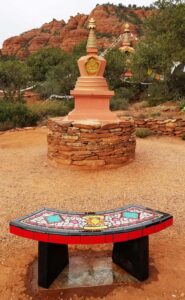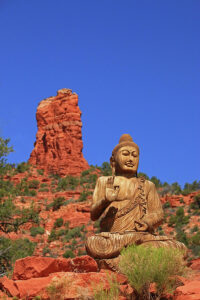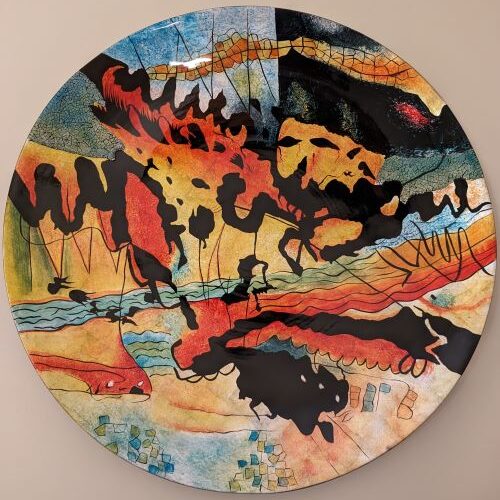The last time we lived in Sedona, Arizona, there was a Buddhist nun living in our neighborhood. We were to learn her name was Metta, the Sanskrit word for lovingkindness. Buddhism teaches that metta is not just an emotion, but rather a cultivated mental state in which our attention and concern are directed toward the happiness of others.
 Although it was strange to see her walking around the neighborhood, it was not all that strange because near our house was the (Buddhist) Amitabha Stupa and Peace Park where many Buddhists meditated.
Although it was strange to see her walking around the neighborhood, it was not all that strange because near our house was the (Buddhist) Amitabha Stupa and Peace Park where many Buddhists meditated.
Metta was ever the Buddhist nun. She wore the traditional saffron and burgundy red robes; she walked barefoot even among the sharp pebbles on our street; she carefully shaved her head.
One day when we were out walking around the neighborhood, we stopped to greet this Buddhist nun. She asked if we were familiar with Buddhism. I shook my head and said “Not really.”
We exchanged names. She said her name was “Metta.”
“Ah,” I said, “Lovingkindness.”
“Ah,” she returned, “You do know Buddhism.”
Metta and I nodded our heads in agreement and that began our friendship as neighbors: Metta, a Buddhist nun and me, a curious student.
Metta was not one to speak at length. Our conversations always centered around Buddhism and her life as a nun, with not much said about her prior life except that she was an American. At some point in her life she became a Buddhist, and then a Theravada Buddhist Forest Nun, taking her vows somewhere in Southeast Asia.
She told me that life for nuns was very difficult just because they were women. As is unfortunately true all too often in this world, the women nuns did not have the status nor the resources of the men. She in fact had no support from any Buddhist organization.
One day Tricycle, a Buddhist magazine, published a major article about Buddhist nuns, highlighting the poor treatment they received from the Buddhist community. We discussed the article, with Metta providing her own personal examples backing up the points made in the article. She had no money, no resources, and truly lived from hand to mouth subsisting on what was put into her traditional begging bowl.
Metta started showing up at our house with her begging bowl, a traditional practice in Asian countries, but not a familiar one in the United States. The practice is for the householder to put into the bowl food to sustain the Buddhist priest or nun.
What should I put into her bowl? She asked for tea, butter, and a razor to shave her head. Over time she asked for a few other items which I can no longer remember.
Meditation is a very important Buddhist practice. One day Metta taught me what is known as “Walking Meditation.” She told me, and showed me, how to walk very very slowly, putting the heel down first, then the rest of the foot, and when that is done, to do the same with the other foot. Heel, ball of foot, heel, ball of foot.
Although Metta walked everywhere — barefoot — on two occasions she asked us to take her in our car. I drove her to another town for a Buddhist event. I don’t know how she returned home.
Speaking of home, what constituted her home were a series of small places in neighbors’ garages, mother-in-law units, and the like. Somehow she was able to live in such sparse, difficult ways.
The other time she asked for a ride was to Flagstaff to catch the train to California for an extended stay. She sat in the back seat of the car not saying a word. I wondered what she was thinking, this lovely Buddhist woman who was the embodiment of lovingkindness, her namesake. What would she find in California? Would she have food, would she be safe, would others be kind to her in return for her peaceful ways?
We never saw Metta again, but she is ever on my mind. Recently I received an email from one of her Sedona supporters. She said Metta was experiencing difficulties and needed financial support which I am providing. What sustains her is her belief, her passion, her commitment to the Buddha.
May she be safe.
May she be sustained.
May she be appreciated.

The Buddha in Sedona, Arizona
Copyright © 2024 by Jane Iddings


“Namaste”
The traditional Indian greeting meaning “The God in me greets the God in you.”
Your piece demonstrates how she touched you and you touched her, greeting one another’s godliness.
Good job, Jane!
Leslie
May we each, when meeting the Mettas in our life, be as generous as you.
I love the beautiful way you ended your story about Metta, Jane. It is apparent that Metta is always on your mind and that you want her to be safe but also appreciated. The readers of your story about this Buddhist nun can now also appreciate her.
Thanks for sharing about a friend who has chosen a different path than we have. The only thing I know about Buddhists is that they are peaceful. You have introduced me to a person who has chosen this life. It has enriched my life to have knowledge of one real person from the world of Buddhism.
Fascinating and hopeful, though also fragile lifestyle. Depending on the help provided by good people as permanent and limited support requires such faith. That this lifestyle exists reminds me of the good in the world. Thank you.
Thank you for the educational and insightful look into a culture I have not been exposed to but am intrigued by. I believe that peace in our world can only come when we open our hearts and minds to understand and accept others. We don’t have to agree with their ways but by respecting their ways we can begin to love others and bring about peace in our world one person at a time Thanks for sharing your story of Metta, the Buddhist Nun, who touched your life.
I very much enjoyed reading this story Jane. I always thought living in Sedona would be interesting. I am so glad you contributed to helping your friend Metta and will find out more about how she is eventually.
Beautiful! It is surprising, sometimes, to be introduced, through a well written piece, to someone whose whole life is very different than our own and to see how meaningful and full of lovingkindness that different lifestyle can be. This is a well written and thought provoking piece.
Linda Hanson